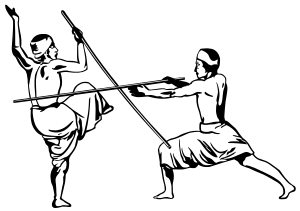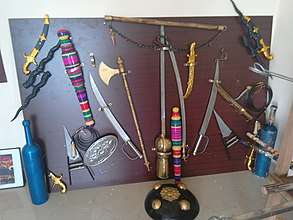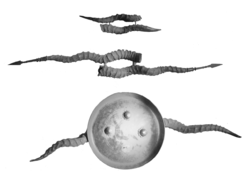Silambam
Silambam is a weapon-based Indian martial art originating in modern-day Tamil Nadu in the Indian subcontinent. This style is mentioned in Tamil Sangam literature 400 BCE.[1]
 | |
| Focus | Weapons |
|---|---|
| Country of origin | India |
| Creator | traditionally Agastya |
| Olympic sport | No |

Origins
References in the Silappadikkaram and other works of Sangam literature shows that silambam has been practiced as far back as the 4th century BC.[2] The bamboo staff - along with swords, pearls and armor - was in great demand with foreign traders.[3][4]
The soldiers of Kings Puli Thevar, Dheeran Chinnamalai had Silambam army named "thadii pattalam", Veerapandiya Kattabomman and Chinna Maruthu and Periya Maruthu (1760–1799) relied mainly on their Silambam prowess in their warfare against the British Army.[3] Indian martial arts suffered a decline after the British colonists banned Silambam along with various other systems. They also introduced modern western military training which favoured fire-arms over traditional weaponry. During this time, Silambam became more common in Southeast Asia than its native India where it was banned by the British rulers.[5]

| Part of a series on |
| Indian martial arts |
|---|
| Styles |
|
| Legendary Figures |
| Notable Practitioners |
| Related terms |
Weapons
Silambam's main focus is on the bamboo staff. The length of the staff depends on the height of the practitioner. Ideally, it should just touch the forehead about three fingers from the head, typically measuring around 1.68 metres (five and a half feet). Different lengths may be used depending on the situation. For instance, the sedikuchi or 3-foot stick can be easily concealed. Separate practice is needed for staffs of different lengths. Listed below are some of the weapons used in Silambam.
- Silambam: staff, preferably made from bamboo, but sometimes also from teak or Indian rose chestnut wood. The staff is immersed in water and strengthened by beating it on the surface of still or running water. It is often tipped with metal rings to prevent the ends from being damaged.
- Maru: a thrusting weapon made from deer horns
- Aruval: sickle, often paired
- Panthukol: staff with balls of fire or weighted chains on each end
- Savuku: whip
- Vaal: sword, generally curved
- Kuttu katai: spiked knuckleduster
- Katti: knife
- Kattari: native push-dagger with a H-shaped handle. Some are capable of piercing armor. The blade may be straight or wavy.
- Surul kaththi: flexible sword
- Sedikuchi: cudgel or short stick, often wielded as a pair.
Training
The first stages of Silambam practice are meant to provide a foundation for fighting and to condition the body for the training itself. This includes improving flexibility, agility, hand-eye coordination, kinesthetic awareness, balance, strength, speed, muscular endurance, and cardiovascular stamina.[6][7]
World Initiatives
Silambam name has made its historical first time appearance in the world eyes as the committee of United Nations Assembly recommends Silambam Asia for United Nations status for representing Asia Continent. Occasion held at the United Nations Headquarters in New York, United States on January 21, 2019 whereby China-Taipei government representatives arised border conflicts in ancient recording pertaining Silambam and requesting organisation of Silambam Asia to resolve prior to internal committee clearance request. On January 30, 2019 concluded substantive work as the Committee recommended Silambam Asia for Special Status in the United Nations.[8]
In Tamil Films
In quite a number of his movies in 1950s and 1960s, M.G.Ramachandran (MGR) had incorporated silambam fighting scenes, to popularize this ancient martial arts in the 20th century. MGR himself was an exponent on silambam fighting he learned this martial art from Madurai Maadakulam Ravi master. Some of these movies include Thaikkupin Tharam, Periya Idathu Penn, Mugaraasi and Thanipiravi.
List of films featuring the martial art form Silambam
| Year | Film | Language(s) | Lead actor(s) / Performer(s) |
|---|---|---|---|
| 1956 | Thaikkupin Tharam | Tamil | M. G. Ramachandran |
| 1962 | Thayai Katha Thanayan | Tamil | M. G. Ramachandran |
| 1963 | Periya Idathu Penn | Tamil | M. G. Ramachandran |
| 1964 | Padagotti | Tamil | M. G. Ramachandran |
| 1966 | Mugaraasi | Tamil | M. G. Ramachandran |
| 1966 | Thanipiravi | Tamil | M. G. Ramachandran |
| 1970 | Maattukara Velan | Tamil | M. G. Ramachandran |
| 1971 | Rickshawkaran | Tamil | M. G. Ramachandran |
| 1976 | Uzhaikkum Karangal | Tamil | M. G. Ramachandran |
| 1978 | Thai Meethu Sathiyam | Tamil | Rajinikanth |
| 1980 | Murattu Kaalai | Tamil | Rajinikanth |
| 1982 | Thooral Ninnu Pochchu | Tamil | K. Bhagyaraj |
| 1983 | Mundhanai Mudichu | Tamil | K. Bhagyaraj |
| 1989 | Karagattakaran | Tamil | Ramarajan |
| 1992 | Thevar Magan | Tamil | Kamal Haasan |
| 1994 | Periya Marudhu | Tamil | Vijayakanth |
| 1995 | Villadhi Villain | Tamil | Sathyaraj |
| 1996 | Amman Kovil Vaasalile | Tamil | Ramarajan |
| 2008 | Silambattam | Tamil | Silambarasan |
| 2010 | Vamsam | Tamil | Kishore |
| 2011 | 7aum Arivu | Tamil | Suriya |
| 2015 | Baahubali: The Beginning | Tamil, Telugu | Prabhas |
| 2018 | Seemaraja | Tamil | Samantha Akkineni |
See also
- Angampora
- Adimurai
- Banshay
- Bataireacht
- Bōjutsu
- Gatka
- Jūkendō
- Kalaripayattu
- Kendo
- Kenjutsu
- Krabi–krabong
- Kuttu Varisai
- Mardani khel
- Silambam
- Silambam Asia
- Tahtib
- Thang-ta
- Varma kalai
- World Silambam Association
- Silat
- Kbachkun boraan
References
- Raj, J. David Manuel (1977). The Origin and the Historical Developlment of Silambam Fencing: An Ancient Self-Defence Sport of India. Oregon: College of Health, Physical Education and Recreation, Univ. of Oregon. pp. 44, 50, 83.
- Balambal, V. (1998). Studies in the History of the Sangam Age. New Delhi: Kalinga Publications. p. 6. ISBN 978-8185163871.
- Raj, J. David Manuel (1977). The Origin and the Historical Development of Silambam Fencing: An Ancient Self-Defence Sport of India. Oregon: College of Health, Physical Education and Recreation, Univ. of Oregon. pp. 44, 50, & 83.
- Sports Authority of India (1987). Indigenous Games and Martial Arts of India. New Delhi: Sports Authority of India. pp. 91 & 94.
- Crego, Robert (2003). Sports and Games of the 18th and 19th Centuries pg 32. Greenwood Press
- Guruji Murugan, Chillayah (20 October 2012). "Silambam health and physical benefits". Silambam. Retrieved 31 May 2013.
- Ministry of Education (1956). National Plan of Physical Education and Recreation Publication No.237. New Delhi: Government of India, Ministry of Education.
- "United Nations grant Special Status for Silambam Asia". un.org. United Nations Meetings Coverage & Press Releases. Retrieved 30 January 2019.